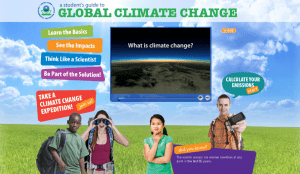At PopEd, we often work with elementary educators who would like to teach issues surrounding climate change, but worry that the content is too scary or complicated for young minds to comprehend. Their uncertainty is understandable – headlines about warming temperatures, rising seas, and stronger storms can sound daunting to even adults let alone the littlest of learners. But understanding the mechanics of climate change and why it is an important issue to tackle does not have to be disheartening. Armed with the right tools and approach, elementary students can become not only aware of the challenges of a changing climate but also feel empowered to take positive action, both locally and globally, in order to combat one of the most pressing global issues of their time.
5 tips for teaching climate change to elementary students
1. Inspire action and tell positive stories
Highlighting the positive impact that young people can have in the fight against climate change is an important ingredient in maintaining motivation. As much as possible, emphasize the contributions students can make in their everyday lives (recycle! use less energy! plant tress!) and share stories of other young children who have made a difference. Like this one of Felix Finkbeiner, who founded Plant for the Planet when he was 9 years old and has now helped plant over a billion trees. More stories like Felix’s can be found at Young Voices for the Planet.
2. Tie it in with what you are already teaching
There are many NGSS requirements that connect with climate change. The mechanics of climate change can be discussed when learning about the Earth’s systems (interactions between the atmosphere, geosphere, hydrosphere, and biosphere) while the impacts of climate change fit nicely with standards related to human impacts on Earth’s systems (5-ESS3.C) and species adaption (3-LS4.C), just to name a couple.
3. Stick to facts from trusted sources
 For older elementary students, looking at trusted data can be a helpful approach when teaching complex issues. Sites like the National Oceanic and Atmospheric Administration (NOAA), NASA, and the EPA are great starting points to gather objective information about various climate indicators including temperature, ice melt, and CO2 emissions. While students may need scaffolding to interpret the information, they will begin to learn what trusted sources look like and can practice interpreting data to form conclusions. There are also many “kid-focused” sites, like Climate Kids (from NASA) or A Students Guide to Global Climate (from the EPA) that can help establish a base knowledge of climate change before jumping into the data.
For older elementary students, looking at trusted data can be a helpful approach when teaching complex issues. Sites like the National Oceanic and Atmospheric Administration (NOAA), NASA, and the EPA are great starting points to gather objective information about various climate indicators including temperature, ice melt, and CO2 emissions. While students may need scaffolding to interpret the information, they will begin to learn what trusted sources look like and can practice interpreting data to form conclusions. There are also many “kid-focused” sites, like Climate Kids (from NASA) or A Students Guide to Global Climate (from the EPA) that can help establish a base knowledge of climate change before jumping into the data.
4. Make it local
Young elementary students are concrete thinkers and there’s no better way to establish a foundation of climate stewardship than to learn about a local environmental issue. Understanding that humans have impacts on the natural world and that wildlife is impacted by changing ecosystems is a must in grades K-2. Spending time exploring local wildlife/habitats and learning about any current risks will establish the ground-work for more abstract climate-related thinking later on.
5. Use Population Education!
Of course, PopEd has several hands-on lesson plans to make learning about climate related issues engaging and fun for elementary learners. In the lesson Energy Imagery, students compare their energy use with that of a person in the past and then brainstorm ideas for a new, unique form on energy. And in the lesson Counting Carbon, students consider their own contributions to daily emissions of CO2 and then participate in a fun carbon sink activity.
Over the next several weeks, PopEd will be sharing more tips and resources for teaching climate change in the classroom. Follow along on Facebook with the hashtag #PopEdClimate!
Image credits: Screenshot of A Student’s Guide to Global Climate Change (EPA)


